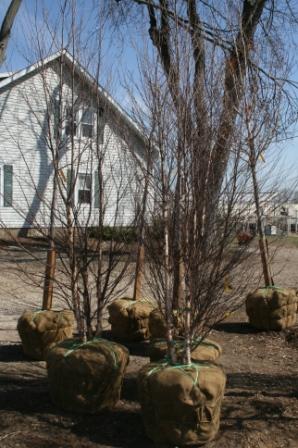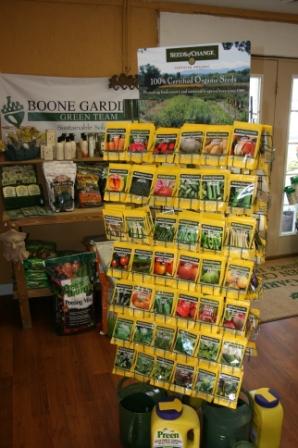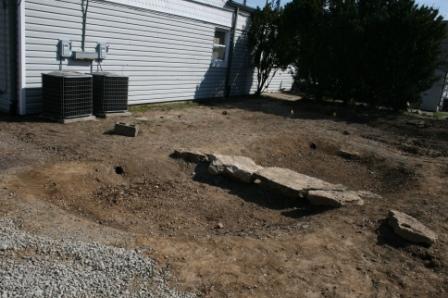by admin | Mar 18, 2009 | Boone's Blog Contributors, Composting, General Info, Green Team, Matt Gardiner, Native Plants, seed starting, sustainability, Uncategorized, Vegetable Gardening
Spring has arrived at Boone Gardiner and we have all kinds of great things to show you. We have hundreds of Kentucky grown trees available to replace trees that you may have lost from storm damage.

New Trees
There are new truck loads of trees and plants arriving daily. We have a wonderful selection of Sustainable and Green Gardening Products such as: composters, rain barrels, herbicides, pesticides and much more. As well as our premier line of organic seeds, Seeds of Change, are in and we have a huge selection of veggies, herbs and flowers seeds for your garden.

Seeds Of Change
We are also doing all kind of great things and renovations to the garden center site. We have added new display gardens, are installing a rain garden demonstration area, a new sustainable materials deck, a veggie demo garden, and much much more.

Rain Garden Construction

New deck being built
by admin | Mar 3, 2009 | Compost Ingredients, Uncategorized, Vegetable Gardening
In order for microorganisms to properly break down your compost pile they require a certain ratio of Carbon to Nitrogen (C: N). It is also possible to have a nervous breakdown worrying about precise ratios and recommended temperatures. There is a multitude of information on techniques, systems and recipes. I think the best approach is to keep in mind the optimal numbers and basic techniques then experiment on your own.
Everything that you put into the compost pile has a C: N ratio. For example, leaves are high in carbon with around a 60:1 ratio and coffee grounds & grass clippings have more nitrogen with a 20:1 ratio. In general, the C: N ratio that you want to achieve in your compost pile is approximately 30:1. The key is to balance the ingredients by alternating layers until you get close to that ratio.
There are a couple of indicators that you have the right ratio of C: N. After a week the center of the pile should be hot to the touch (around 130 degrees Fahrenheit). If the pile is not hot then you probably have too much carbon. Another clue that your ratio is off is a very stinky pile. Excessive nitrogen causes excessive smells from the pile. Additional carbon is the solution here.
by admin | Feb 4, 2009 | Uncategorized, Vegetable Gardening
The UK Extension office has a great resource for home Vegetable Gardening.
Below is the link to the guide:
http://www.ca.uky.edu/agc/pubs/id/id128/id128.pdf
by admin | Feb 4, 2009 | Compost Ingredients, Uncategorized, Vegetable Gardening
- Black walnut tree leaves or twigs releases substances that might be harmful to plants
- Coal or charcoal ash might contain substances harmful to plants
- Dairy products (e.g., butter, egg yolks, milk, sour cream, yogurt) create odor problems and attract pests such as rodents and flies
- Diseased or insect-ridden plants might survive and be transferred back to other plants
- Fats, grease, lard, or oils create odor problems and attract pests such as rodents and flies
- Meat or fish bones and scraps create odor problems and attract pests such as rodents and flies
- Pet wastes (e.g., dog or cat feces, soiled cat litter) might contain parasites, bacteria, germs, pathogens, and viruses harmful to humans
- Yard trimmings treated with chemical pesticides might kill beneficial composting organisms
by admin | Feb 4, 2009 | Compost Ingredients, Uncategorized, Vegetable Gardening
- Animal manure (excluding dog waste)
- Cardboard rolls
- Clean paper
- Coffee grounds and filters
- Cotton rags
- Dryer and vacuum cleaner lint
- Eggshells
- Fireplace ashes
- Fruits and vegetables
- Grass clippings
- Hair and fur
- Hay and straw
- Houseplants
- Leaves
- Nut shells
- Sawdust
- Shredded newspaper
- Tea bags
- Wood chips
- Wool rags
- Yard trimmings
by admin | Jan 23, 2009 | Uncategorized, Vegetable Gardening
The warm weather today is a good reminder that spring will be here soon. It is time to pull out those seed catalogs and start thinking about fresh tomatoes from the backyard garden!




Recent Comments